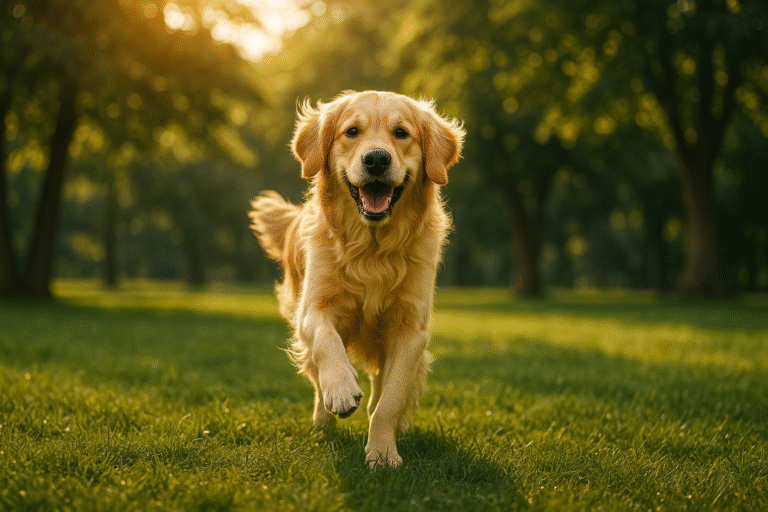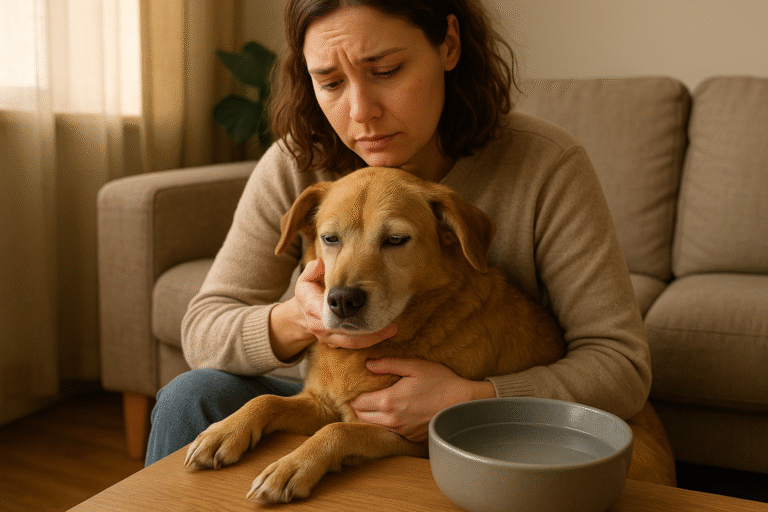
Ultimate Guide to Raising a Happy & Healthy Pet Dog
Introduction: The Joy of Having a Dog
Owning a dog brings endless love, companionship, and happiness. Dogs are more than pets—they are loyal friends who make our lives brighter. Whether you’re a first-time owner or an experienced dog lover, understanding how to care for your furry friend is key to a long, joyful life together.
Table of Contents
ToggleThis complete guide covers everything you need to know about raising a happy and healthy dog—feeding, grooming, training, exercise, and emotional bonding.
1. Understanding Your Dog’s Needs
1.1 Physical Needs
Dogs need proper food, clean water, exercise, and a safe space to live. Meeting these basic needs ensures good health and energy.
Food: Choose a balanced diet suited to your dog’s age, breed, and activity level.
Water: Always keep fresh, clean water available.
Exercise: Daily walks and play sessions help maintain fitness and reduce stress.
1.2 Emotional Needs
Dogs thrive on love and attention. They get anxious if left alone for long hours. Spend time with your dog daily—play, talk, or simply sit together.
1.3 Mental Stimulation
A bored dog may develop bad habits like chewing or barking. Use puzzle toys, training games, and outdoor activities to keep your dog mentally active.
2. Choosing the Right Dog
2.1 Consider Your Lifestyle
Before adopting a dog, think about your daily routine.
Active lifestyle? Consider breeds like Labrador Retrievers or Border Collies.
Apartment living? Small, low-energy breeds like Pugs or French Bulldogs may be perfect.
Family with children? Golden Retrievers and Beagles are friendly and gentle.
2.2 Adopt, Don’t Shop
Many dogs in shelters are waiting for loving homes. Adopting not only saves a life but also brings unconditional love into your home.
2.3 Budget Planning
Owning a dog involves expenses—food, grooming, vet visits, and vaccinations. Plan ahead so you can provide the best care without financial stress.
3. Feeding Your Dog Right
3.1 Understanding Dog Nutrition
A healthy diet supports strong bones, shiny fur, and long life. The main nutrients your dog needs include:
Proteins: For muscle growth and energy.
Carbohydrates: For stamina and digestion.
Fats: For skin health and coat shine.
Vitamins and Minerals: To strengthen immunity.
3.2 Feeding Schedule
Most adult dogs do well with two meals per day—morning and evening. Puppies may need three to four smaller meals. Keep a consistent feeding time to maintain routine.
3.3 Foods to Avoid
Some human foods can be toxic to dogs. Avoid:
Chocolate
Onions and garlic
Grapes and raisins
Alcohol and caffeine
Cooked bones
3.4 Treats in Moderation
Use treats only as rewards during training. Too many treats can cause obesity. Choose healthy options like carrots, apple slices, or dog biscuits.
4. Training and Behavior
4.1 Importance of Early Training
Training builds trust and communication. Start basic obedience early—commands like sit, stay, come, and heel make life easier for both of you.
4.2 Positive Reinforcement
Reward good behavior with praise, treats, or petting. Never hit or shout; it only causes fear. Consistency and patience are key to effective training.
4.3 Socialization
Expose your dog to new people, pets, and environments. Early socialization helps reduce aggression and fear later in life.
4.4 Handling Common Behavior Problems
- Chewing: Provide chew toys and limit boredom.
- Barking: Identify the cause—loneliness, fear, or excitement—and address it calmly.
- Jumping: Ignore until your dog calms down, then reward calm behavior.
5. Exercise and Play
5.1 Daily Walks
Walking isn’t just about physical fitness—it’s mental stimulation too. Regular walks allow your dog to explore scents and sights.
5.2 Fun Games
Play fetch, tug-of-war, or hide-and-seek to build a strong bond. Playtime also helps release excess energy and prevent destructive habits.
5.3 Breed-Specific Exercise Needs
Some breeds need more activity:
High energy: Huskies, Dalmatians, Border Collies.
Moderate: Beagles, Cocker Spaniels.
Low: Bulldogs, Basset Hounds.
6. Grooming and Hygiene
6.1 Brushing
Regular brushing keeps the coat clean, reduces shedding, and improves blood circulation. Choose a brush suitable for your dog’s coat type.
6.2 Bathing
Bathe your dog every 3–4 weeks or when needed. Use a mild, dog-friendly shampoo. Avoid over-bathing as it can dry out the skin.
6.3 Nail Trimming
Long nails can cause pain or injury. Trim nails once every 3–4 weeks, or have a groomer do it safely.
6.4 Dental Care
Brush your dog’s teeth 2–3 times a week using pet toothpaste. Dental chews and toys also help maintain oral hygiene.
7. Health Care and Veterinary Visits
7.1 Regular Checkups
Schedule annual health exams to detect problems early. Routine vet visits include vaccinations, weight checks, and dental cleaning.
7.2 Vaccinations
Protect your dog from deadly diseases. Common vaccines include:
Rabies
Distemper
Parvovirus
Canine hepatitis
7.3 Parasite Control
Use vet-approved preventives for fleas, ticks, and worms. Check your dog’s skin regularly for signs of infection or irritation.
7.4 Spaying or Neutering
Spaying or neutering helps control overpopulation and prevents certain cancers. Talk to your vet about the right time for your dog.
8. Building a Strong Emotional Bond
8.1 Spend Quality Time
Dogs are happiest when they feel loved. Play, talk, and cuddle regularly. A simple belly rub can mean the world to your pet.
8.2 Understand Body Language
Learn to read signs like wagging tails, raised ears, or growls. Understanding these signals strengthens communication.
8.3 Positive Routine
Dogs love structure. A regular schedule for feeding, walking, and sleeping gives them security and peace.
9. Traveling with Your Dog
9.1 Preparation
Before traveling, pack essentials: food, water, leash, ID tag, and vaccination papers.
9.2 Safety Tips
Use a seatbelt harness or travel crate. Never leave your dog alone in a parked car.
9.3 Acclimation
Take short trips first. Gradually increase duration so your dog gets used to the car environment.
10. Common Dog Health Issues
10.1 Allergies
Dogs can suffer from food or environmental allergies. Symptoms include itching, redness, or ear infections. Consult your vet for tests and treatment.
10.2 Obesity
Overfeeding and lack of exercise lead to obesity. Maintain a balanced diet and regular walks.
10.3 Ear and Eye Infections
Check ears and eyes regularly for discharge or odor. Clean gently with vet-recommended solutions.
10.4 Arthritis in Older Dogs
Provide soft bedding and moderate exercise. Supplements like glucosamine can help ease joint pain.
11. Senior Dog Care
As dogs age, they need extra love and medical attention.
- Feed easily digestible food.
- Visit the vet more often.
- Provide a comfortable, warm place to rest.
- Be patient—older dogs may move slower but still crave affection.
12. The Power of Love and Companionship
Dogs give unconditional love without expecting much in return. Their loyalty and affection remind us what pure love looks like. Taking care of a dog may require time and effort, but the joy they bring makes it all worthwhile.
Conclusion: A Happy Dog Means a Happy Home
A well-cared-for dog becomes part of your family. With proper feeding, training, exercise, and affection, your furry companion will live a long, happy life. The key to raising a healthy dog lies in understanding, patience, and love.
Remember—a happy dog doesn’t just wag its tail; it wags your heart too. ❤️
FAQs
1. What is the best food for pet dogs?
The best food depends on your dog’s age, breed, and health. High-quality commercial dog food with real meat, whole grains, and essential nutrients is ideal. Avoid foods containing artificial colors or fillers. Always check with your vet before switching diets.
2. How often should I feed my dog?
Most adult dogs should be fed twice a day, while puppies may need 3–4 smaller meals. Stick to a consistent schedule to support good digestion and prevent overeating.
3. How much exercise does my dog need daily?
Dogs generally need 30 minutes to 2 hours of physical activity daily. The amount varies by breed—active breeds like Labradors or Huskies require more exercise than smaller or low-energy breeds.
4. How often should I bathe my dog?
Bathe your dog every 3 to 4 weeks, or when they get dirty. Over-bathing can dry out the skin and coat. Use only mild, dog-friendly shampoos and warm water.
5. When should I take my dog to the vet?
Schedule a vet check-up once or twice a year for vaccines and preventive care. Puppies and senior dogs may require more frequent visits. Always see a vet if your dog shows signs of illness such as vomiting, loss of appetite, or lethargy.
6. Is home-cooked food good for dogs?
Yes, but only if it’s nutritionally balanced. Include lean meats, vegetables, and grains, and avoid toxic foods like onions, garlic, chocolate, and grapes. Always consult a vet or pet nutritionist before switching to homemade meals.
7. How do I train my dog effectively?
Use positive reinforcement—reward good behavior with treats, toys, or praise. Be patient, consistent, and avoid harsh punishment. Start training early with simple commands like sit, stay, and come.
8. What are signs that my dog is healthy?
A healthy dog has bright eyes, clean ears, a shiny coat, good appetite, and playful energy. Regular eating, drinking, and bowel movements are also signs of good health.
9. How can I prevent my dog from getting fleas or ticks?
Use vet-approved flea and tick preventives regularly. Keep your dog’s bedding clean and inspect their skin after outdoor walks. Avoid home remedies without consulting your vet.
10. Should I spay or neuter my dog?
Yes, it’s recommended. Spaying or neutering prevents unwanted litters and reduces the risk of certain cancers. It also helps control behavior issues like aggression and roaming.
Recent Posts









Related Topics
Copyright © 2025 The Pet Blog – Expert Tips, Care Guides & Fun Facts for Every Pet Lover.


